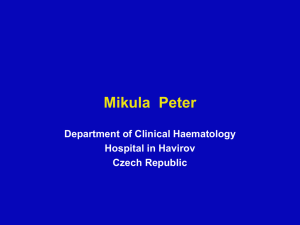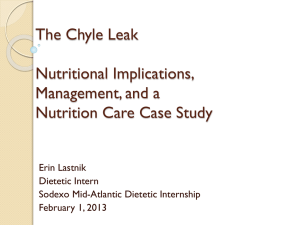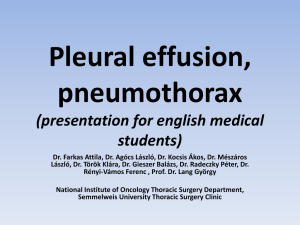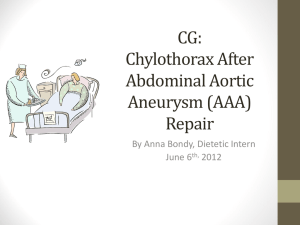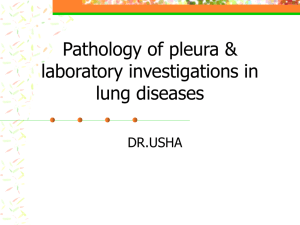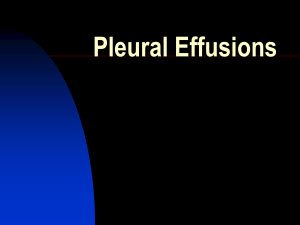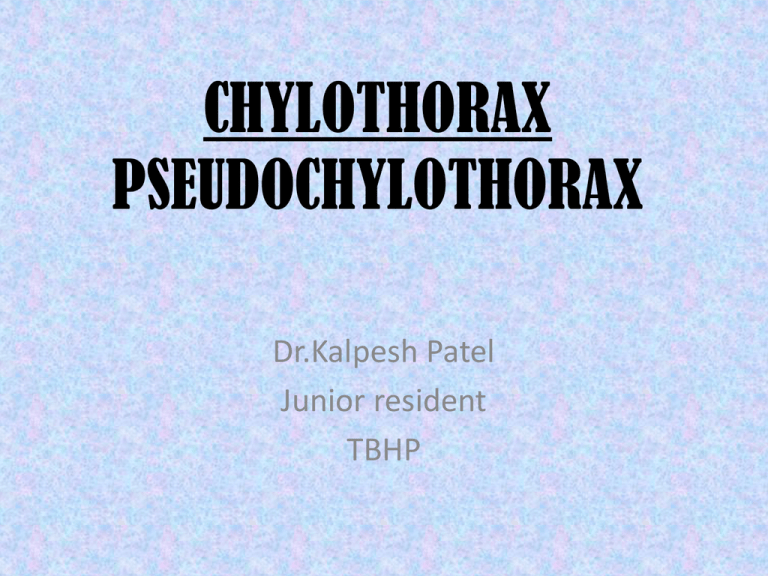
CHYLOTHORAX
PSEUDOCHYLOTHORAX
Dr.Kalpesh Patel
Junior resident
TBHP
Chylothorax
• Definition :
– It is an accumulation of fluid, rich in triglyceride
and characterized by the presence of
chylomicrons in the pleural space.
• Chylothorax is formed when the thoracic duct
is disrupted and chyle enters the pleural
space.
Thoracic duct
• It is the largest lymphatic vessel of lymphatic system.
• Function – transport of digestive fat to the venous system.
• Also known as left lymphatic duct, alimentary duct,
chyliferous duct and van Hoome’s canal.
• In adult, thoracic duct is typically 38-45 cm in length and
average diameter of about 5 mm.
• It drains into the systemic circulation at the brachiocephalic
vein between the left subclavian and left internal jugular
veins.
• It collects most of the lymph in the body other than from
right side which is drained by right lymphatic duct.
Anatomy
•
•
•
•
•
•
Davis (1915) “Constant only in its
variability”
Originates from the cisterna chyli.
Enters thorax through aortic
hiatus.
Ascends along anterior surface of
the vertebral bodies.
Posterior to esophagus, between
the aorta and the azygos vein.
At T5-T7 crosses to the left
behind the aorta and ascends on
left side of the esophagus
• Above clavicle, duct turns
laterally.
• It turns inferiorly to enter
the venous system at the
subclavian-internal jugular
vein junction.
• A bicuspid valve prevents
entry of blood into the
lymphatic system.
• The right duct is small (2cm
in length). Drains lymph
from right head, and chest.
• Injury below T5 to T6
results in right
chylothorax.
• Injury above this level
results in left chylothorax.
Chyle
• The drainage from the thoracic duct is called
chyle.
• Chyle is a milky bodily fluid consisting
of lymph and emulsified fats, or free fatty
acids (FFAs).
• It is formed in the small intestine during
digestion of fatty foods, and taken up by
lymph vessels specifically known as lacteals.
• Chyle separates into three layers upon standing:
– a creamy uppermost layer containing chylomicrons,
– a milky intermediate layer, and
– a dependent layer containing cellular elements, most of
which are small lymphocytes
• Each day, between 1,500 and 2,500 mL of chyle
normally empties into the venous system.
• Factors affecting chyle flow :
– Ingestion of fat can increase the flow of lymph in the
thoracic duct by 2 to 10 times the resting level.
– Ingestion of liquid also increases the chyle flow.
– Ingestion of protein or carbohydrates has little effect.
Etiology….
Modified DeMeester classification of chylothorax
• Congenital
– Atresia of thoracic duct
– Birth trauma
– Pleural thoracic duct fistula
• Traumatic
– Blunt
– Penetrating
– Surgical
• Cervical
– Excision of lymph nodes
– Radical neck dissection
• Thoracic
–
–
–
–
–
Ligation of patent ductus arteriosus
Surgery for coarctation of aorta/aortic aneurysm
Post-esophagectomy
Surgery for mediastinal tumours
Post-pneumonectomy
• Abdominal
–
–
–
–
–
Post-sympathectomy
Radical lymph node dissection
Diagnostic procedures
Lumbar arteriography
Subclavian vein catheterisation
• Neoplasms
• Miscellaneous
Congenital Chylothorax
• Congenital chylothorax is the
leading cause of pleural effusion in
the neonate.
• Fluid initially clear but turns turbid
with milk feeding.
• Causes include birth trauma and
congenital duct defect.
• Associated with a variety of
congenital syndromes like Turner's
syndrome, Noonan's syndrome, or
Down's syndrome.
• Congenital chylothorax is also
more common in infants who are
hydropic or who have
polyhydramnios .
• Most neonatal chylothoraces are
either right-sided or bilateral; only
rarely are they left-sided.
Traumatic
• Trauma is the leading cause of chylothorax.
• Iatrogenic causes chiefly Thoracic surgery constitute the
majority.
• Oesophageal resection is perhaps the most common
iatrogenic cause of chylothorax, with an incidence of 4% .
• More likely in patients who undergo oesophageal resection
by the transhiatal approach than the thoracic approach.
• Other surgical procedures in the vicinity of the thoracic
duct can inadvertently damage the thoracic duct.
Laceration of the thoracic duct during catheterisation of the
subclavian vein can lead to a chyle leak. Extensive venous
thrombosis complicating central venous catheterisation has
resulted in bilateral chylothorax and chylopericardium .
• Non-iatrogenic causes are responsible for approximately
20% of cases of traumatic chylothorax.
• Thoracic duct injury can occur following hyperextension
of the cervical vertebral column and fracture-dislocation
of the spine.
• Chylothorax secondary to closed trauma is usually on the
right side, and the site of rupture is most commonly in
the region of the 9th or 10th thoracic vertebra. Such
trauma includes falls from a height, motor vehicle
accidents, compression injuries to the trunk, heavy
blows to the back or stomach, and childbirth.
Neoplasms
• Malignancy is one of the leading cause of chylothorax, 50% of
chylothoraces in adults caused by tumors.
• The most common malignancy to cause a chylothorax is a
lymphoma and accounted for 75% of the chylothoraces due to
malignancies.
• Benign and malignant tumors may involve thoracic duct
through lymphatic permeation, direct invasion or tumor
embolus.
• Most frequently found malignant tumors include lymphomas,
lymphosarcomas, and primary lung carcinomas.
• Benign lesions of the thoracic duct include: lymphangiomas,
mediastinal hygromas, and pulmonary
lymphangioleiomyomatosis.
Miscellaneous
• Thrombosis of the superior vena cava or the
subclavian vein – more common.
• Hepatic cirrhosis - chylous pleural effusion
results from the transdiaphragmatic passage
of chylous ascitic fluid. Majority of hepatic
chylothoraces are right sided.
• Rarely associated with heart failure, nephrotic
syndrome resulting in transudative chylous
effusion.
• Other causes include
– Gorham's syndrome,
– Kaposi's sarcoma in patients with acquired
immunodeficiency syndrome (AIDS),
– filariasis,
– giant lymph node hyperplasia (Castleman's
disease),
– lymphangiomatosis,
– familial lymphedema,
– lymphangitis of the thoracic duct,
– obstruction of the superior vena cava secondary
to Bechet's syndrome,
– tuberculosis,
– sarcoidosis involving the intrathoracic lymph
nodes,
– aneurysms of the thoracic aorta that erode the
duct,
– abnormalities of the lymphatic vessels such as
intestinal lymphangiectasis or reticular
hyperplasia,
– radiation-induced mediastinal fibrosis, and
– hypothyroidism
Clinical manifestations
• The symptoms, physical findings, and
radiographic features of chylothorax are the same
as those encountered in patients with
comparably sized pleural effusions of any cause.
• Half of all chylothoraces are right-sided, one-third
is left-sided, and the remainder are bilateral.
• Pleuritic chest pain and fever are rare because
chyle is not proinflammatory.
• With nontraumatic chylothorax, insidious onset
of dyspnea on exertion is common.
• With traumatic chylothorax, there is usually a latent
period of 2 to 10 days between the trauma and the
clinical presentation of the pleural effusion. During this
latent period, chyle may accumulate in the posterior
mediastinum to form a chyloma—visible radiologically
as a posterior mediastinal mass—which eventually
ruptures into the pleural cavity, giving rise to a
chylothorax.
• Neonatal chylothorax may present with respiratory
distress in the first few days of life. Fifty percent of the
infants have symptoms within the first 24 hours,
whereas 75% have symptoms by the end of the first
week.
• Rarely, patients may experience a rapid accumulation
of fluid in the pleural space, causing a tension
chylothorax. This is of particular concern following a
pneumonectomy. These patients experience a rapid
hemodynamic and respiratory compromise, similar to
classic tension pneumothorax.
• The main threat to life with chylothorax is inanition
from malnutrition if the chyle is drained externally.
• The daily loss of 1.5 to 2.5 L of fluid rich in protein, fats,
electrolytes, and lymphocytes will rapidly render
patients malnourished and immunocompromised.
• Continued loss of proteins, immunoglobulins,
and T-lymphocytes into the pleural space
leads to immunosuppression. Furthermore, Blymphocyte-mediated immune functions are
impaired by prolonged chyle drainage.
• These factors predispose the patient to
opportunistic infections. However, infection of
a chylothorax itself is very uncommon because
chyle is inherently bacteriostatic.
• Electrolyte imbalance also occur.
Diagnosis
• Distinctive white, odorless, milky appearance – suggestive of
chylothorax
• But requires differentiation from empyema and pseudochylothorax.
• The milkiness with empyema is caused by the suspended white
blood cells (WBCs), and debris and if such fluid is centrifuged, the
supernatant is clear.
• Chylous and chyliform pleural fluids remain opaque after
centrifugation.
• If cholesterol crystals are responsible for the turbidity, they may be
easily demonstrated by examination of the pleural fluid sediment.
• If the turbidity is due to high levels of cholesterol, the turbidity will
clear when 1 to 2 mL of ethyl ether is added to a test tube
containing the fluid.
• If the turbidity is due to chylomicrons or lecithin complexes, the
turbidity does not clear.
Appearance…
• Not all chylous pleural effusions have the
typical, milky appearance. With congenital
chylothorax, the pleural fluid is initially serous
and turns chylous only when milk feedings are
started.
• Chylothorax usually meets exudative criteria,
but can be transudative.
• Pleural fluid analysis for triglyceride content
helps to confirm a diagnosis of chylothorax.
Triglyceride measurement
• A level greater than 110 mg/dL reflects a 99%
chance that the fluid is chyle.
• A level less than 50 mg/dL reflects only a 5%
chance that the fluid is chyle.
• If the level is 50-110 mg/dL, use lipoprotein
analysis to inspect the pleural fluid for
chylomicrons or cholesterol crystals.
• If the pleural fluid triglyceride level is above 110
mg/dL and
Ratio of the pleural fluid to serum cholesterol is
less than 1.0, the diagnosis of chylothorax is
established.
• A ratio of pleural fluid cholesterol to triglyceride
of less than 1 is also diagnostic.
• Cholesterol ratio is used to exclude
pseudochylothorax.
Only other situation in which the pleural fluid
triglyceride is above 110 mg/dL is when intravenous
fluid containing high levels of triglycerides leaks from
a central vein into the pleural space.
Fasting may significantly reduce the triglyceride level
in the pleural fluid and produce false-negative results
having serous-appearing pleural fluid. To confirm the
diagnosis, feed with high fat meal before sampling.
Chylomicrons
If any doubt persist…..
• The demonstration of chylomicrons in the
pleural fluid by lipoprotein analysis establishes
the diagnosis of chylothorax.
Lipophilic Dye Ingestion
• Ingestion of a fatty meal with a lipophilic dye,
followed by a thoracocentesis 30 to 60
minutes later, to ascertain whether the pleural
fluid has changed in color.
• Most commonly used dye is Drug and
Cosmetic Green No. 6, a coal-tar dye.
Imaging of thoracic duct
• Lymphoscintigraphy : Technetium-99m human
serum albumin is injected into the dorsum of
the foot or hand and subsequently the
thoracic duct is imaged in nuclear medicine.
• Oral ingestion of iodine labelled BMIPP, the
thoracic duct can be imaged approximately 80
minutes later.
Imaging studies
• Chest roentgenography with lateral views as well
as decubitus views may be helpful in determining
the size and location of the chylothorax.
• CT is useful when chylothorax is associated with
trauma, or where an underlying tumour is
suspected. Patients with chylothorax and no
obvious trauma must undergo CT Chest and
abdomen to look for lymphadenopathy, also
useful in the diagnosis of
lymphangioleiomyomatosis.
• MRI can confirm the high fat density of the
pleural effusion and may support the
diagnosis of chylothorax.
• 3D MRI with lymphoscintigraphy can provide
additional anatomical and functional details of
the lymphatic channels additional anatomical
and functional details of the lymphatic
channels.
• N/B : examination of the pleura is unlikely to
provide insight to the etiology of the
chylothorax.
• Hence, pleural biopsy or thoracoscopy is not
usually indicated in the workup of patients
with a chylothorax.
Treatment….
Treatment
• It should be directed towards :
1. Maintaining nutrition and reducing the flow
of chyle,
2. Relieving dyspnea by removing the chyle, and
3. Closure of the defect.
Maintaining Nutrition and Reducing the Volume of Chyle
Circulation
• Nil per oral or or a diet rich in low-fat, mediumchain triglycerides.
• The patients nutritional status can be maintained
with intravenous hyperailmentation.
• It is preferred than medium chain triglycerides
which are unpalatable and are recommended
when one wishes to reduce the flow.
• The flow of chyle is also decreased if the patient
stays in bed because any lower extremity
movement increases the flow of lymph.
Octreotide (somatostatin analogue)
• Administered subcutaneously.
• It decreases lymphatic flow and triglyceride
absorption.
• Mechanism of action unknown. Presumed lymphatic
vessels may have somatostatin receptors and their
stimulation could result in decreased lymphatic flow .
• Side effects are related to suppressive actions of
gastrointestinal motility and secretion and include
loose stools, malabsorption, nausea, and flatulence.
• Dose : in Adult 50 mg 8 hrly
in children 0.3 to 1 mcg/kg/hr
• Somatostatin :
• Continuous i.v. infusion.
• Usual starting dose is 3.5 mcg/kg/hr can be
increased upto 12 mcg/kg/hr.
• Adverse effects includes diarrhea,
hypoglycemia, and hypotension.
Relieving Dyspnea by Removing Chyle
from the Pleural Cavity
• Thoracentesis (short term only)
• Tube thoracostomy (short term only)
– To decompress the pleural space and to keep the
lung expanded against the chest wall and
mediastinum.
– every attempt should be made to minimize the
duration of tube drainage to avoid malnutrition or
immunosuppression.
Pleuroperitoneal Shunt :
• Optimal method to remove the chyle and alleviate the
dyspnea.
• Advantages :
– Lymph is not removed from the body, and, therefore, the
patient does not become malnourished or
immunocompromised.
– Can be inserted with local anesthesia as opposed to
general anesthesia, which is required for thoracic duct
ligation
• When the chyle is shunted to the peritoneal cavity, it is
absorbed without creating significant ascites.
• When a pleuroperitoneal shunt is implanted, the
defect closes spontaneously in most cases and the
shunt can be removed 30 to 90 days after its
insertion.
• Contraindicated if ascites is present, and is less likely
to be successful if the chylothoraces result from
central venous thrombosis.
Redirection of the chyle back into the systemic
circulation has also been performed successfully via
pleurovenous shunts
Surgical management
• Indications for surgical intervention include the
following:
– Chyle leak greater than 1 L/d for 5 days or a
persistent leak for more than 2 weeks despite
conservative management
– Nutritional or metabolic complications, including
electrolyte depletion and immunosuppression
– Loculated chylothorax, fibrin clots, or trapped lung
– Postesophagectomy chylothorax (Patients with
this carry a high mortality rate if treated
conservatively.)
Percutaneous Transabdominal
Thoracic Duct Blockage
• Minimally invasive and relatively effective.
• Developed by Cope and Kaiser
• Pedal lymphography is initially performed to opacify
large retroperitoneal lymph channels. Then a suitable
duct (one that is more than 2 mm in diameter) is
punctured transabdominally to allow catheterization
and embolization of the thoracic duct under
fluoroscopic guidance.
• Embolization is performed using platinum microcoils or
microparticles.
• Glue has also been used singly or in combination with
coils being more efficient to prevent recanalization.
Ligation of the Thoracic Duct through Thoracotomy
• Definitive treatment for postoperative chylothorax.
• Causes no ill effects (because of multiple anastomosis among
various lymphatic channels and direct lymphatico-venous
communication).
• Lampson first demonstrated successful ligation in 1948.
• Usually, the side of the chylothorax is ipsilateral to the original
surgery, and reoperation can be performed through the
original thoracotomy incision.
• If the chylothorax is unilateral, the thoracotomy should be
performed on the side of the fluid.
• If the chylothorax is bilateral, a right thoracotomy should be
performed because the duct is more readily approached from
that side.
• Prerequisite : preoperative lymphangiogram should be
obtained in every case to demostrate the site of leak or
obstruction.
• For identifying the thoracic duct intraoperatively Evans blue
dye is injected in subcutaneous tissue of the leg, Within 5
minutes, the chyle will be stained blue.
Dose 0.7 to 0.8 mg/kg, total dose not exceeding 25 mg.
• Or place a tube in the duodenum and inject cream.
• One should attempt to find the actual point of leakage from
the duct and ligate the duct on both sides of the leak.
• Parietal pleurectomy should be performed to obliterate the
pleural space, if required.
• If leak cannot be located the thoracic duct should be
ligated.
• Alternative approach by Mason et al., who recommends
ligation of thoracic duct just below the diaphragm through
an intraabdominal approach.
Ligation of the Thoracic Duct through
Thoracoscopy
• With video-assisted thoracic surgery (VATS),
ligation of the thoracic duct can be done with
the videothoracoscope.
• Thoracoscopy permits the entire pleural space
to be visualized, as well as allowing direct
suture of a lymphatic leak.
• Wurnig et al. reported the successful use of
VATS with ligation of the thoracic duct
immediately above the diaphragm.
Pleurodesis
• When the thoracic duct is unidentifiable, talc
pleurodesis
could be tried.
• It has a success rate of 95% and negligible morbidity.
• When the chylothorax is complicated, loculated, or
the site of chyle leak cannot be established, pleural
decortication and surgical pleurodesis may be
indicated.
• Fibrin glue has also been used to seal chyle leak by
inducing pleurodesis .
Special considerations…
Nontraumatic Chylothorax
• In general, the goals of management of nontraumatic
chylothorax are the same as for traumatic chylothorax.
• Establishment of cause is necessary.
• The possibility of lymphoma should be considered in all
patients with a nontraumatic chylothorax because it is
the most common cause of nontraumatic chylothorax.
• Mediastinal radiation adequately controlled the
chylothorax for the remainder of the patient's life in
68% of those with lymphoma and in 50% of those with
metastatic carcinoma.
• If radiation therapy fails, embolization, pleurodesis, or
pleuroperitoneal shunting should be considered.
• If the characteristics of the chyle are
transudative, (low protein,low LDH), then
most likely etiologies are cirrhosis, congestive
heart failure, and the nephrotic syndrome.
• The chylothorax associated with cirrhosis can
be treated by a transjugular intrahepatic
portosystemic shunt.
• The chylothorax associated with thrombosis of
the superior vena cava can resolve with the
use of thrombolytic therapy and placement of
a self expanding metallic stent.
• Chylothorax associated with sarcoidosis is
likely to disappear if the patient is treated
with corticosteroids.
• If the cause of a nontraumatic chylothorax is
unknown and,
• If chest CT and lymphangiography are normal,
the chylothorax can be assumed to be due to
minor trauma, and spontaneous closure can
be expected within weeks.
Fetal and Congenital Chylothorax
• Chylothorax is the most common type of pleural effusion in
infants. Chylothorax in infancy can be fatal.
• If diagnosed in utero, maternal dietary restriction should be
initiated.
• Thoracentesis can be performed under ultrasound
guidance to evacuate the chylothorax, as large effusions
can cause pulmonary hypoplasia and respiratory distress at
birth.
• If the chylothorax reaccumulates, pleuro-amniotic shunting
should be considered.
• Also ultrasound-guided intrapleural administration of OK432 or maternal blood has offered effective control of the
chylothorax, presumably via creating a pleurodesis.
In neonates…..
• Initially, treat conservatively with repeated
thoracenteses.
• Total parenteral nutrition.
• If the chylothorax recurs after the third pleural
aspiration, a pleuroperitoneal shunt should be inserted.
• Alternatively, octreotide can be administered.
• Thoracic duct ligation is indicated if the
pleuroperitoneal shunting fails. The advantage of the
shunt over the thoracic duct ligation is that it is a much
simpler procedure.
Gorham’s Syndrome
• Gorham's syndrome is a rare disease that can
occur at any age but is most often recognized
in children or young adults. There is no sex
predilection and no inheritance pattern.
• The characteristic lesion of Gorham's
syndrome is an intraosseous proliferation of
vascular or lymphatic channels that leads to
the disappearance of bones.
• Patients with Gorham's syndrome have a high
incidence of chylothorax
• All the patients with Gorham's syndrome and
chylothorax had a rib, scapular, clavicular, or
thoracic vertebral bony involvement
• Patients with Gorham's syndrome and
chylothorax should be treated with a
pleuroperitoneal shunt or thoracic duct
ligation
Pulmonary Lymphangiomyomatosis
• Pulmonary lymphangioleiomyomatosis (LAM) is a
rare condition, affecting mostly women of
reproductive age, and is characterized by progressive
dyspnea, recurrent pneumothoraces, and chylous
effusions .
• The reported incidence of chylothorax in patients
with LAM ranges from 10% to 30%. It can occur in
both the sporadic and the tuberous sclerosis
complex–associated types of LAM—the former is
associated with a higher incidence of chylothorax
• The chylothorax is thought to be the result of the
combination of perilymphatic proliferation of smooth
muscle leading to lymphatic obstruction and of
infiltration of the lymph nodes in the mediastinum
and retroperitoneal space by immature smooth
muscle cells.
• CT scan is usually diagnostic for LAM
• The chylothorax associated with LAM should be
managed as are chylothoraces secondary to other
medical conditions. If the chylothorax is small and is
asymptomatic, it need not be treated. If it is larger, it
is probably best treated with thoracoscopic ligation
of the thoracic duct or the implantation of a
pleuroperitoneal shunt.
Prognosis of chylothorax
• In the past, the mortality due to chylothorax was in excess of
50%.
• Currently, the morbidity and mortality have improved due to
the more aggressive management strategies adopted.
• Introduction of aggressive therapeutic measures to reverse
the adverse effects of chyle loss has led to the lowering of
mortality rates for post-traumatic chylothorax.
• Malignant chylothorax, chronic debilitating chylothorax and
bilateral chylothoraces have worse prognosis.
• The success of managing large chyle leaks involves aggressive
nutritional support and early surgical intervention when
indicated.
Pseudochylothorax
• Pseudochylothorax, also known as chyliform
pleural effusion or cholesterol pleural effusion, is
the term applied to pleural fluid that mimics true
chylous pleural effusion in appearance but lacks
the biochemical criteria for chylothorax.
• High cholesterol levels are typical of a
pseudochylous pleural effusion.
• Cholesterol levels are generally >200 mg/dl and
may even exceed 1000 mg/dl.
• The fluid may demonstrate rhomboid-shaped
cholesterol crystals on microscopy, which do not
stain with Sudan III stain.
Pathogenesis….
• Most patients with chyliform pleural effusions have
long-standing pleural effusions (mean >5 years), and
have thickened, at times, calcified pleura.
• Most of the cholesterol in chyliform pleural effusions
is associated with high-density lipoproteins in
contrast to the cholesterol in acute exudates that is
mostly bound to low-density lipoprotein (LDLs).
• The precise origin of cholesterol in
pseudochylothorax is unknown, but it is attributed to
the continued breakdown of chronic inflammatory
cells in a long-standing effusion.
• Chyliform pleural effusions are usually unilateral
Causes….
• Tubercular pleural effusions account for
approximately 54% of all cases.
• Rheumatoid arthritis and trapped lung
syndrome are rare causes of
pseudochylothorax.
• Patients who have had artificial
pneumothoraces for pulmonary tuberculosis
and in whom the lung remains atelectatic with
a resultant pleural effusion are particularly
prone to chyliform pleural effusions.
Clinical features
• Many patients with chyliform pleural effusions
are asymptomatic or at least no more
symptomatic than when they initially
developed the pleural effusion.
• When symptoms occur, they are usually
related to the underlying disease process or to
the pulmonary restriction produced by the
effusion and the thickened pleura.
Diagnosis
• The pleural effusion is often chronic and associated with
thickened or calcified pleura.
• The fluid is milky, and the differential diagnoses of
chylothorax and empyema need exclusion.
• Cholesterol crystals—a diagnostic feature of
pseudochylothorax.
• The cholesterol crystals give a distinct satin-like sheen to the
pleural fluid and microscopically have a typical rhomboid
appearance.
• Not all patients with chyliform pleural effusion have
cholesterol crystals in their pleural fluid; however, most have
an elevated pleural fluid cholesterol level (>250 mg/dL, or
6.45 mmol/L).Pleural fluid triglyceride levels can be high in
pseudochylothorax.
Treatment
• When a patient is diagnosed as having a
chyliform pleural effusion, the possibility of
tuberculosis should always be entertained.
• A therapeutic thoracentesis should be
performed.
• Decortication should be considered if the
patient is symptomatic and the underlying
lung is believed to be functional .
Working algorithm in the management of chylothorax.
Results of Fluid
Analysis
Pseudochylothorax
Chylothorax
• TG level
• <50 mg/dl
> 110 mg/dl
• Cholesterol level
• >200 mg/dl
< 200 mg/dl
• Cholesteral crystals • Yes, common
No
•Chylomicrons
• No
Yes
• Disease process is
Disease process is
usually chronic &
usually acute 2
pleural surfaces are
pleural surfaces not
thickened
thickened.
66

